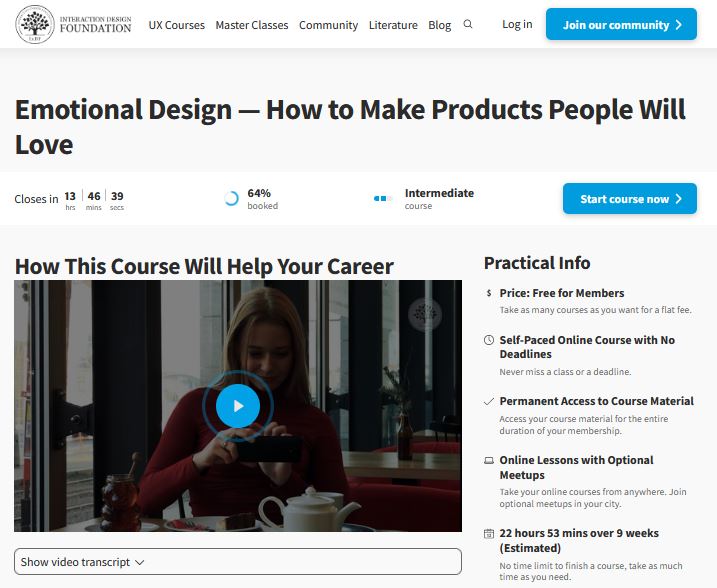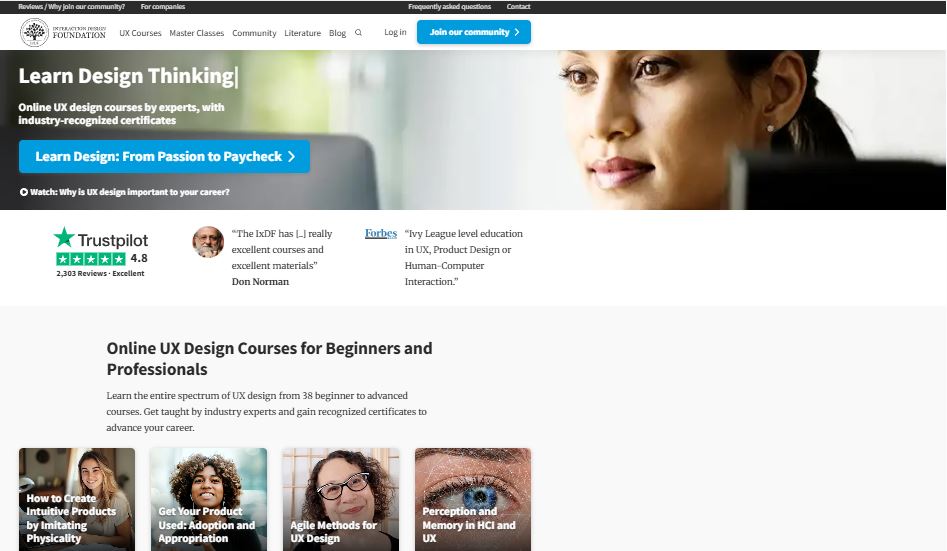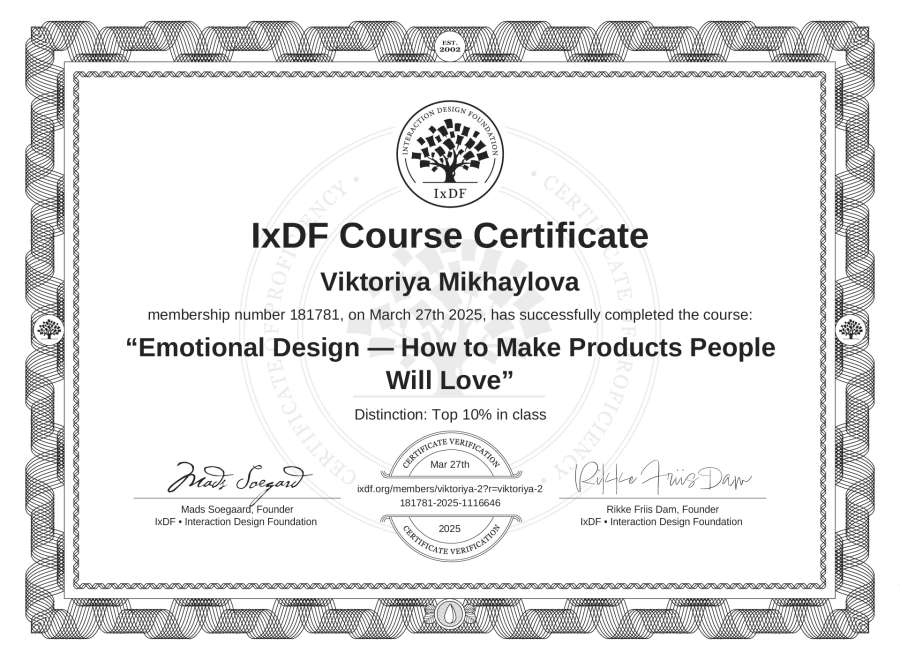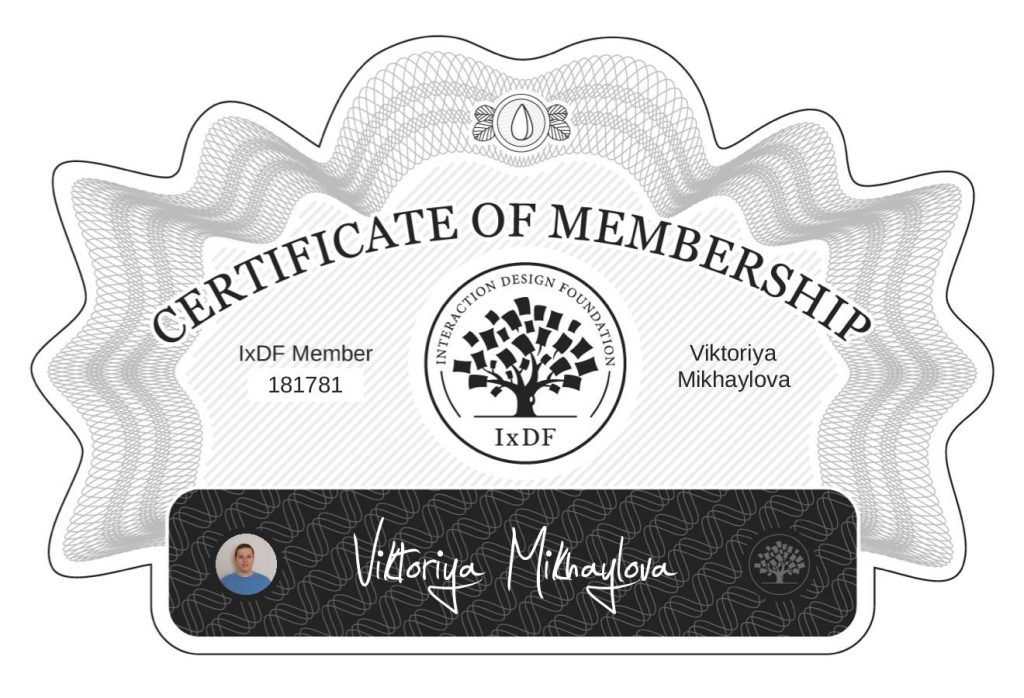As someone passionate about creating user-centered designs, my experience with the Interaction Design Foundation (IxDF) has been transformative. One of the standout moments in my design career was completing the course Emotional Design – How to Make Products People Will Love. Earning the certificate from this course not only deepened my understanding of design but also helped me shape how I approach product creation with a more empathetic and emotional lens. Here’s a look back at my journey and the invaluable knowledge I gained along the way.

Why I Chose IxDF to Learn UI/UX Design and How It Will Shape My Future
As a passionate UI/UX designer, I’ve always believed that continuous learning is key to staying relevant in the fast-paced design industry. This led me to the Interaction Design Foundation (IxDF), a platform I chose to deepen my knowledge and grow as a professional. At the time, I was looking for a structured, accessible way to sharpen my skills and better understand the evolving demands of the field. IxDF’s courses offered the ideal mix of practical knowledge and theoretical grounding, making it the perfect choice for advancing my career.

Applying Emotions in Design
One of the key takeaways from the Emotional Design course was the crucial role emotions play in shaping user experiences. Before the course, I understood that functionality and usability were important, but I had never fully appreciated how deeply emotions influence user behavior. Through the course, I mastered how to apply emotional design principles to enhance the User Experience (UX) of a product.
Emotional design isn’t just about making products look appealing; it’s about connecting with users on a psychological level. I learned to craft experiences that make users feel something — whether it’s joy, excitement, satisfaction, or even nostalgia. This emotional connection often leads to a more memorable and positive interaction with the product, making it much more likely that users will engage with it regularly.
Designing for Positive Emotional Experiences
The course also taught me how designing for positive emotions can lead to better product adoption and increased sales. I started focusing on the emotional journey users go through when interacting with a product — from the first impression to continued use. Every detail, from color choice to interaction flow, now serves a purpose in evoking specific emotions that encourage users to form a bond with the product.
By designing with empathy and creating positive emotional experiences, I’ve seen firsthand how users are more likely to adopt a product. They feel good using it, and that satisfaction drives long-term engagement. The course provided me with concrete strategies to evoke feelings of trust, excitement, and delight, which has made a tangible difference in how products resonate with users.
Managing Emotions Throughout the Product Lifecycle
Perhaps one of the most eye-opening parts of the course was understanding the need to manage the emotional user experience throughout the entire lifecycle of a product. A product isn’t just about the initial interaction; it’s about sustaining a positive emotional experience from the moment a user first encounters it, all the way through its evolution.
I now apply this principle by regularly evaluating how my designs might make users feel at each touchpoint. Whether it’s the onboarding process, the in-app experience, or customer support interactions, I’ve learned to optimize the entire user journey. This continuous management ensures that users always feel valued, which helps maintain their trust and loyalty.
Evaluating and Improving Emotional Impact
Another invaluable skill I gained was learning how to evaluate and improve the emotional impact of existing user interfaces. Designing with emotions in mind from scratch is one thing, but what about working with an established product? The course taught me how to assess how users emotionally respond to a product, whether through usability testing, user feedback, or analytics.
Armed with this knowledge, I’m now able to tweak and improve user interfaces to better align with the emotional needs of users. For example, I learned how to address negative emotional triggers, such as frustration or confusion, and replace them with positive interactions that leave users feeling satisfied and empowered.
Thanks to the learning materials from the IxDF Emotional Design course, I was inspired to start my own blog focused on UI/UX design. The course not only deepened my understanding of how emotions influence user experience but also motivated me to share these insights with others. As a result, I realized that writing about design from an emotional perspective could resonate with a wider audience, particularly within the Finnish design community. Through my blog, I aim to explore how emotional connections play a critical role in creating successful and user-centered designs. It has been a rewarding way to reflect on the course’s lessons, continue learning, and improve my Finnish writing skills.
A New Perspective on Design
The Emotional Design course by IxDF has reshaped the way I think about product design. It’s no longer just about functionality, aesthetics, or usability; it’s about how the product makes users feel. By focusing on emotional connections, I’ve not only enhanced the user experience but also contributed to the overall success of the product.
What’s exciting is that emotional design is a field that continues to evolve. The skills I gained in the course have equipped me with the tools to stay ahead of design trends and consistently create products that users love. I’m truly grateful to the Interaction Design Foundation for providing such a comprehensive, hands-on learning experience that has made me a better designer and a more empathetic problem solver.
A Free Gift Just for You!
I’m offering you the chance to join IxDF and learn UX Design from industry professionals at IxDF, and get 3 months for free when you purchase a one-year membership!
IxDF is an incredible place to learn, with a thriving, active community of like-minded learners and design professionals. It’s the perfect opportunity to grow your skills and expand your knowledge in UX design.
Don’t miss out—sign up below and start learning today!
Wishing you the best of luck on your journey into the UI/UX design field!
Enhance Your Design Skills: Join IxDF’s Emotional Design Course or Access Free Resources
If you’re looking to elevate your design skills and make your products resonate with users on a deeper level, I highly recommend checking out the IxDF and enrolling in their Emotional Design course. I hope it’s a valuable investment not only for your career and the lasting impact on your work but also for the meaningful contribution you can make in the world of design. Alternatively, you can explore IxDF’s free literature on Emotional Design (ED) to gain valuable insights and enhance your understanding of the subject. The key difference between the two options is that after completing the course, you’ll receive an IxDF certificate, which isn’t provided when studying the free materials.

More information about the Emotional Design — How to Make Products People Will Love course: https://www.interaction-design.org/courses/emotional-design-how-to-make-products-people-will-love?r=viktoriya-2
Learn more and enroll at Interaction Design Foundation.
Sources:
Interaction Design Foundation – IxDF. 2025. Emotional Design — How to Make Products People Will Love course. https://www.interaction-design.org/courses/emotional-design-how-to-make-products-people-will-love?r=viktoriya-2
Interaction Design Foundation – IxDF. (2016, June 3). What is Emotional Design (ED)?. Interaction Design Foundation – IxDF. https://www.interaction-design.org/literature/topics/emotional-design?r=viktoriya-2


